
Microsoft Surface Pro – Copilot+ PC - 12" (Netzteil separat erhältlich)
12", 512 GB, 16 GB, Without keyboard layout, Snapdragon X Plus X1P-42-100

The Surface Pro with its 12-inch display is compact, practical and incredibly quiet, but its fanless design can limit performance. This is consistent with the tablet’s slow UFS memory.
Compared to its larger siblings, the new Surface Pro with a 12-inch display has a bit less of everything. It has a smaller display, is only available with IPS (no OLED option), has a less powerful Snapdragon chip, no fan and slower memory. It’s still not a bad device, but the tablet with an optional keyboard is primarily suited to users who rarely copy large numbers of files or do a lot of compiling.
In short, if you want more than Office, surfing and occasional image editing, you’ll struggle.
The 12-inch Surface Pro’s currently Microsoft’s least equipped convertible. The model I’m testing is metallic purple, weighs 686 grammes and appears to be as solidly built as ever. Another impressive feature is that you can’t see any fan vents. If you don’t like fan noise, you’re safe thanks to passive cooling. I’ll cover how much CPU performance is lost as a result later.

Microsoft Surface Pro – Copilot+ PC - 12" (Netzteil separat erhältlich)
12", 512 GB, 16 GB, Without keyboard layout, Snapdragon X Plus X1P-42-100
Besides violet, this mini Surface is also available in the silvery shades Ocean and Platinum.
However, there’s no choice of display. You get a 12-inch IPS display in 3:2 format with a resolution of 2196 × 1464 pixels. It runs at a default refresh rate of 60 Hz, but you can switch it to 90 Hz. Its full-screen brightness is up to 400 nits. This is enough for working indoors, but – combined with its reflective surface – you’ll find it tricky to use outdoors in sunlight. During testing, it delivered a relatively good representation of sRGB content with 94 per cent colour space coverage, but struggled with Adobe RGB (65 per cent) and DCI P3 (66.9 per cent).
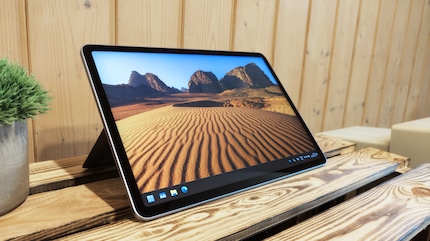
There’s no choice of processor or RAM either. You get 16 gigabytes (GB) of SDRAM and the weakest version of the Qualcomm Snapdragon X: the X Plus with 8 cores. The Snapdragon SoC features a powerful enough NPU (up to 45 TOPS) to meet Microsoft’s Copilot+ PC standard. The chip’s iGPU’s a pretty slow Adreno X1-45. Graphics are the Achilles’ heel of the first Snapdragon X generation.
There’s not exactly an embarrassment of riches in terms of standard storage either. Your options are 256 GB, 512 GB and 1 TB. However, only the latter offers a genuine PCIe SSD i.e. fast «notebook storage». The 256 and 512 GB models are equipped with Universal Flash Storage (UFS), usually used in smartphones and tablets outside of Windows. It’s much faster than traditional hard drives. However, UFS 4.0, for example, is around 43 per cent slower than a PCIe Gen 4 SSD when reading, 59 per cent slower when writing, and up to 90 per cent slower when accessing parallel files. The difference can be quite noticeable when multitasking, using VM workflows and carrying out large file operations.
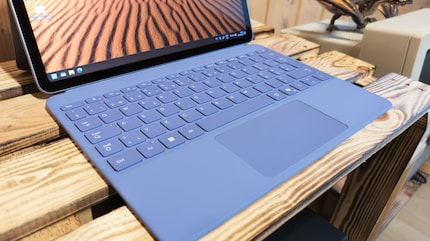
The fact that Microsoft’s relying on «second-rate» storage doesn’t fit with the great look and pretty high price. Especially since you only get a tablet. There’s no keyboard and pen – such as with the Surface Pro 12-inch keyboard with its Slim Pen.
What’s more, the new keyboard adapted to the smaller tablet isn’t as useful. It can only be used flat and no longer has a recess for charging the stylus. You now have to charge it on the back of the tablet.
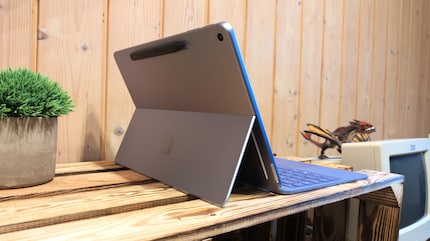
The small tablet’s ports are minimalist. Microsoft has finally moved away from its proprietary, fiddly charging port. Now you charge where you plug in anything else – the USB-C port. There are two version 3.2 ports on the right side.
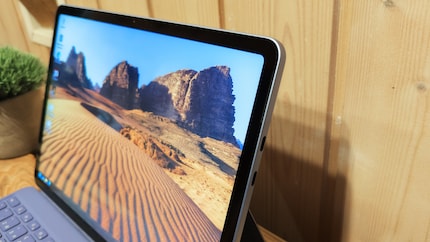
Did I mention that the new Surface devices (except for the business versions) don’t come with a charger? There’s only one cable.
The tablet’s hidden connectivity is a bit more flexible. It supports Wi-Fi 7 and Bluetooth 5.4. And once you’re online, the microphones and Full HD front-facing camera make it easy to join meetings. You can use Windows Hello face recognition to unlock the tablet via the infrared camera and take snapshots with the UHD rear camera.
The small Surface Pro has a Qualcomm ARM chip and a version of Windows 11 adapted for ARM. This has drawbacks compared to «standard» Windows for AMD and Intel chips with x86 architecture.
Many programs beyond Office and browsers – especially games – aren’t yet available natively for Windows 11 ARM. However, you can still use some of them because the ARM processors emulate programs written for the x86 architecture. But emulated software requires more processing power than software written for ARM.
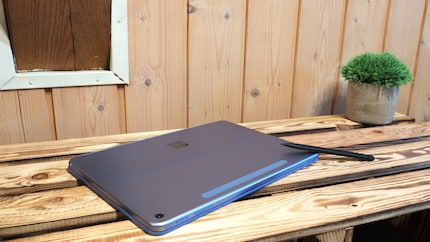
When emulated, performance is easily good enough for a smooth experience with virtually all non-native programs – except for software that requires a lot of power. This includes extensive video editing with Adobe Premiere Pro. Adobe is working on optimising its programs for ARM. There are already native versions of Photoshop, Lightroom and Fresco. Adobe Acrobat Pro and Premiere also work, but only in emulation. After Effects and Dreamweaver, however, aren’t available.
You can find out in detail which software can be used natively, emulated or not at all at windowsonarm.org.
To test the processor performance, I use Geekbench 6 and Cinebench 2024.
During testing, I pitted the passively cooled 12-inch tablet against the following competitors, all of which were actively cooled: 13-inch Microsoft Surface laptop with the same chip (Qualcomm Snapdragon X Plus), 13-inch Microsoft Surface Pro with Qualcomm Snapdragon X Elite X1E-80-100, 13-inch Microsoft Surface Pro with Intel Core Ultra 7 268V and Asus Zenbook S 16 with AMD Ryzen AI 9 HX 370.
Since Geekbench is one of the shorter tests, the 12-inch tablet’s passive cooling’s only a minor disadvantage. Nevertheless, it was last in both multi-core and single-core tests. Of course, its eight cores don’t stand a chance against competitors with more cores (X Elite and Ryzen AI) in terms of multi-core performance.
Cinebench puts more strain on the CPU, resulting in a bigger gap from the competition in the multi-core test. The passive cooling system clearly lags behind the Surface laptop, which uses the same CPU but actively cools it. However, the results in the single-core test are almost identical.
Bottom line: considering the tablet’s passive cooling, the performance is a pleasant surprise.
To test the iGPU, I run the Geekbench 6 graphics test with OpenCL and the Vulkan API. I also render images with 3DMark Wild Life Extreme Unlimited. The rest of the test remains the same.
The 13-inch Surface Pro with its better Qualcomm chip’s already clearly lagging behind the competition from AMD and Intel. I’ve always considered it a poor solution. But the Plus chip with Adreno X-45 performs even worse, scoring roughly half.
The 3DMark graphics test confirms Geekbench’s results.
I use 3DMark Fire Strike to test how well devices perform when gaming at 1080p resolution using DirectX 11. The graph displays a blue overall score, green graphics scores, yellow CPU scores and a combined score.
Gaming’s barely possible with the new Microsoft tablet. Even Steamdeck-level gaming – as with current AMD SoCs – is a long way off.
PCMark 10 Professional Edition can be used to test battery performance using various standardised scenarios (200 nits brightness, Wi-Fi etc. disabled). I tested battery life using the Video profile. I had to leave out the Modern Office and Gaming profiles in this review, as they don’t yet run on Windows 11 for ARM chips. The video test repeatedly plays the same video locally until the battery dies.
Despite a small 37 Wh battery, the mini tablet manages to play over 15 hours of videos locally. The standard low display brightness during testing is enough for binge-watching in a dark room. The weak chip’s actually an advantage for less intensive tasks, providing a good battery life that – for once – surpasses the more powerful chips in my test.
I tested the purple version with a Swiss keyboard. Currently, only «silver» versions are available in the EU shop – like the one linked at the end of this article.
The 12-inch Surface Pro is a 2-in-1 device that sells itself on its appearance: lightweight, metallic purple, quiet and robust. Anyone looking for a compact tablet for office work, media consumption and occasional photo editing will find this a well-rounded, discreetly efficient workhorse.
If you work with large files, use VMs or run a lot of software in parallel, you’ll quickly find it struggling. The Snapdragon X Plus with passive cooling can deliver noticeably lower performance during longer multi-core tasks. The standard storage is UFS instead of PCIe, and only the 1 TB model comes with an SSD. There’s a minimal range of ports, and a keyboard and stylus cost extra.
The convertible scores highly with its very good battery life – especially with less intensive tasks. So, anyone looking for a lightweight, quiet device for everyday use might be satisfied. At least if it doesn’t matter that devices with better «inner workings» are available for the same price.
Pro
Contra
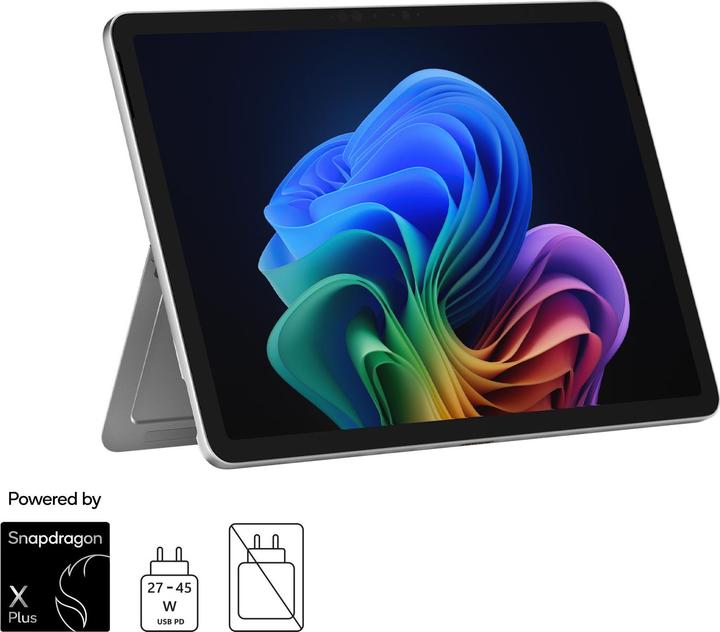
Microsoft Surface Pro – Copilot+ PC - 12" (Netzteil separat erhältlich)
12", 256.00 GB, 16 GB, Without keyboard layout, Snapdragon X Plus X1P-42-100
I find my muse in everything. When I don’t, I draw inspiration from daydreaming. After all, if you dream, you don’t sleep through life.